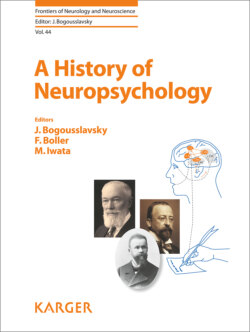Читать книгу A History of Neuropsychology - Группа авторов - Страница 73
На сайте Литреса книга снята с продажи.
Deconstruction
ОглавлениеIn 1906, the dominant Broca-Wernicke-Dejerine paradigm was unexpectedly and doggedly assailed by Pierre Marie (1853–1940) [36, 37]. Marie had trained with both Broca and Charcot, and later he succeeded Dejerine to Charcot’s neurology chair at the Salpêtrière. Marie did not accept the dogma of cerebral centers specialized for language. He pointed out that during the long course of human evolution and culture, reading and writing were relatively recent developments. It was illogical to presume that specialized centers had evolved for these purposes [38]. Marie acknowledged but one variety of aphasia. This was Wernicke’s aphasia, which occurred after lesions within a broadly defined left hemisphere Wernicke’s “zone” that included cortex and white matter tracts of the angular and supramarginal gyri and the posterior superior and middle temporal gyri [36]. Broca’s aphasia was simply mild Wernicke’s aphasia from a Wernicke zone lesion, coupled with dysarthria when the lesion extended beneath Broca’s area to the lenticular nucleus (caudate and putamen). Because it lay within the same vascular territory, the left third frontal convolution was often affected by a stroke that caused symptoms of Broca’s aphasia. However, injury to Broca’s area was incidental and irrelevant.
Wernicke zone lesions affected not just language but all aspects of intelligence dependent on didactic learning [37]. Alexia and agraphia did not exist apart from aphasia. Like Broca’s area, the angular gyrus had no special role: “One cannot recognize in the [angular gyrus] the role of the center for visual images of words” (p 500) [37].
Marie’s iconoclasm resonated with English neurologist Henry Head (1861–1940), who in 1926 published his monumental Aphasia and Kindred Disorders [39]. Studying patients with brain trauma suffered during World War I, Head conceived all aphasia as impairment in “symbolic formulation and expression” (vol 1, p 218) in which speech, reading, and writing were affected in concert. He denounced “diagram makers” like Bastian and Wernicke for “serene dogmatism” (vol 1, p 57) [39] and championed Hughlings Jackson’s writings.
Along similar lines, Kurt Goldstein (1878–1965), a pupil of Wernicke who worked in Germany and the United States, proposed that the fundamental impairment in brain-injured patients was in “abstract attitude.” Like Hughlings Jackson, Goldstein denied “a simple relation between a symptom and a lesion in a circumscribed area” (p 50) [40]. Symptoms were influenced by the “condition of the rest of the brain, and even of the whole organism” (p 256) [41].
